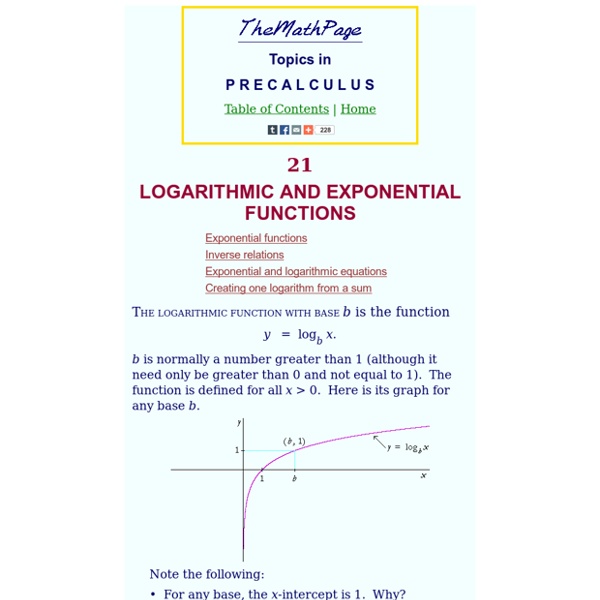Logarithmic and exponential functions - Topics in precalculus

http://www.themathpage.com/aprecalc/logarithmic-exponential-functions.htm
Logarithms: Introduction to "The Relationship"
Purplemath offers a complete lessonon the topic you have selected.Try the lesson below! This lesson is not yet availablein MathHelp.com. Logarithms: Introduction to "The Relationship" (page 1 of 3) Sections: Introduction to logs, Simplifying log expressions, Common and natural logs
Proofs of Logarithm Properties
OML Search In these lessons, we will look at the four properties of logarithms and their proofs. They are the product rule, quotient rule, power rule and change of base rule. You may also want to look at the lesson on how to use the logarithm properties. Related Topics: More Algebra Lessons Free Math Worksheets
Exponential and Logarithmic functions
Exponential functions Definition Take a > 0 and not equal to 1 . Then, the function defined by f : R -> R : x -> ax
CHANGING THE BASE OF A LOGARITHM
Let a, b, and x be positive real numbers such that and (remember x must be greater than 0).
Basic Log Rules / Expanding Log Expressions
Basic Log Rules / Expanding Logarithmic Expressions (page 1 of 5) Sections: Basic log rules, Expanding, Simplifying, Trick questions, Change-of-Base formula You have learned various rules for manipulating and simplifying expressions with exponents, such as the rule that says that x3 × x5 equals x8 because you can add the exponents. There are similar rules for logarithms. Log Rules: 1) logb(mn) = logb(m) + logb(n)
The Change-of-Base Formula
The Change-of-Base Formula (page 5 of 5) Sections: Basic log rules, Expanding, Simplifying, Trick questions, Change-of-Base formula There is one other log "rule", but it's more of a formula than a rule.
Working with Exponents and Logarithms
What is an Exponent? What is a Logarithm? A Logarithm goes the other way. It asks the question "what exponent produced this?": And answers it like this:
Related:
Related:



